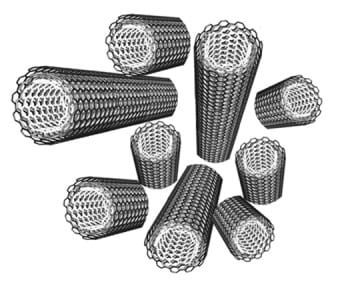 Carbon nanotubes (CNTs) molecules have unusual properties, which are valuable for nanotechnology, electronics, optics and other fields of materials science and technology. In particular, owing to their extraordinary thermal conductivity and mechanical and electrical properties, carbon nanotubes find applications as additives to various structural materials. As a matter of course, tools like nano-hammers or nano-saws does not exist. Tooling CNTs is anything but easy and requires special treatment and carbon chemistry.
Carbon nanotubes (CNTs) molecules have unusual properties, which are valuable for nanotechnology, electronics, optics and other fields of materials science and technology. In particular, owing to their extraordinary thermal conductivity and mechanical and electrical properties, carbon nanotubes find applications as additives to various structural materials. As a matter of course, tools like nano-hammers or nano-saws does not exist. Tooling CNTs is anything but easy and requires special treatment and carbon chemistry.
Recently, scientists from Technical University of Denmark in Roskilde and the Max-Planck Institute for Colloids and Interfaces in Potsdam, Germany, applied a relatively controllable method to peel CNTs and form nanoprotrusion structures with certain lengths. Thus, systematic studies of surface chemistry can be carried out on the nanoprotrusion by loading metal nanoparticles.
 In their current work, acid oxidation on ball-milled CNTs oxidized the shortened CNTs, modified the defects and resulted in an altered morphology in general. By contrast with the conventional refluxing treatment in HNO3, the scientists deploy a lower temperature. Oxidizing ball-milled CNTs at a lower temperature might enhance the removing selectivity of damaged walls with high degrees of defects, but not the walls with higher graphitic degrees.
In their current work, acid oxidation on ball-milled CNTs oxidized the shortened CNTs, modified the defects and resulted in an altered morphology in general. By contrast with the conventional refluxing treatment in HNO3, the scientists deploy a lower temperature. Oxidizing ball-milled CNTs at a lower temperature might enhance the removing selectivity of damaged walls with high degrees of defects, but not the walls with higher graphitic degrees.
More importantly, they conducted sonication in acid solution before heat treatment. Sufficient sonication was important to break CNT bundles and achieve well-dispersed CNTs for later treatments. Such a progressive method enhanced the nanoprotrusion formation by discriminating the chemically activated ends from the rest of CNTs step-wise.
As for the structural alternation introduced by HNO3 treatment applied at present, the Danish and German researchers will carry out Raman analyses in future work. So far, concluded by transmission electron microscopy, they state that the higher graphitic walls remained intact on the same source of CNTs after HNO3 treatment.
Featured Image: Grant Cochrane / FreeDigitalPhotos.net

















